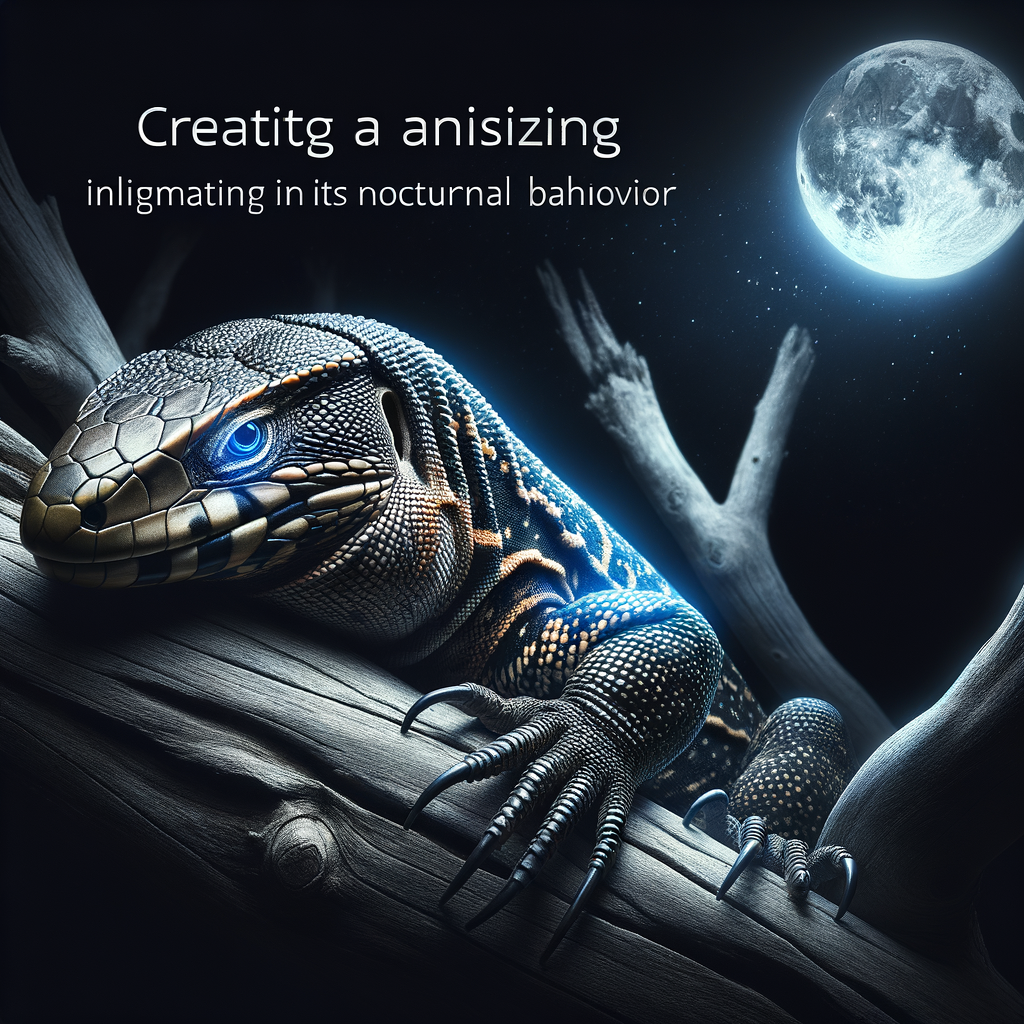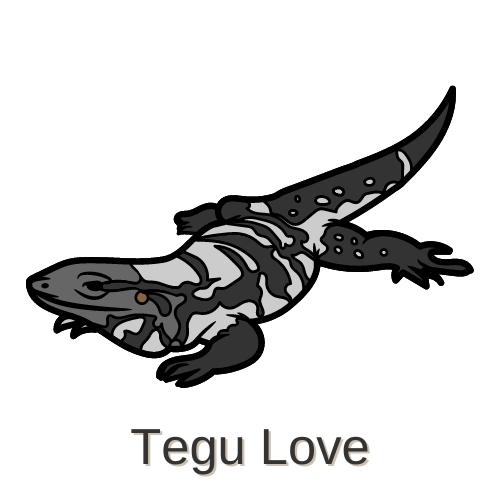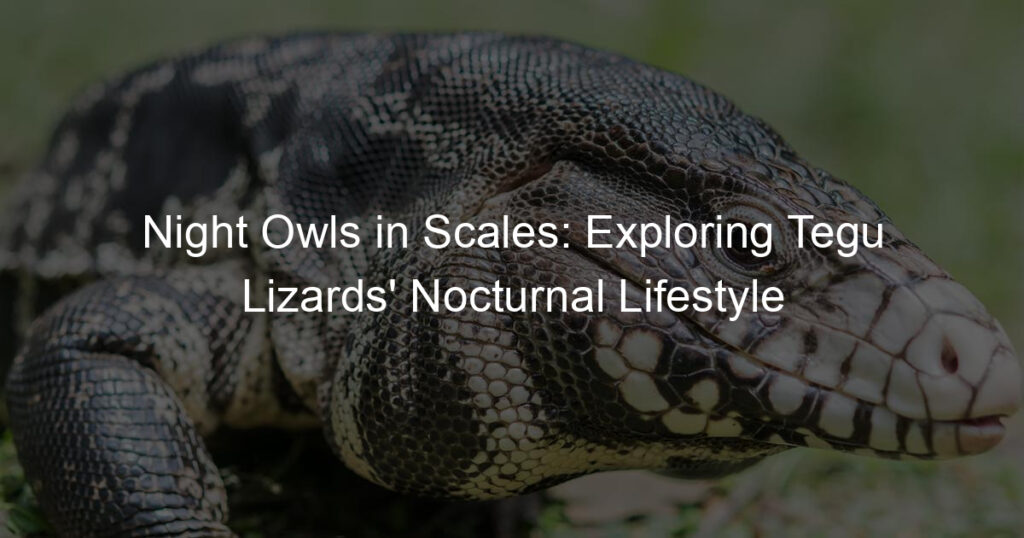
Introduction to Tegu Lizards’ Nocturnal Lifestyle
When the sun sets and the moon takes its place in the sky, a fascinating transformation takes place in the world of Tegu lizards. These intriguing creatures shift from their daytime routines to embrace a nocturnal lifestyle, full of unique behaviors and habits. In this blog post, we will delve into the nocturnal lifestyle of Tegu lizards, providing an overview of these creatures and an understanding of their night habits.
-
- Overview of Tegu Lizards
Tegu lizards, native to South America, are known for their large size and distinctive appearance. They can grow up to 4.5 feet in length, with males typically larger than females. Tegus are omnivorous, consuming a wide variety of food including fruits, vegetables, insects, and small animals. During the day, they are often seen basking in the sun or burrowing in the soil. But when night falls, their behavior changes dramatically.
-
- Understanding the Night Habits of Tegu Lizards
As nocturnal creatures, Tegu lizards are active during the night. They use this time to hunt for food, explore their surroundings, and engage in social behaviors. Their excellent night vision and acute sense of smell aid them in navigating the dark. Interestingly, Tegus also exhibit a unique behavior known as ‘thermoregulation’ where they adjust their body temperature to match their environment, a trait particularly useful during the cooler nights.
In the following sections, we will delve deeper into the nocturnal behavior of Tegu lizards, their nighttime routine, and a case study observing their behavior in the wild. By understanding these aspects, we can gain a comprehensive insight into the nocturnal lifestyle of these fascinating creatures.
Tegu Lizards Night Habits
Understanding the nocturnal habits of Tegu lizards can provide valuable insights into their behavior and lifestyle. In this section, we will delve into their feeding habits during the night.
Feeding Habits
Tegu lizards are omnivorous creatures, meaning they consume both plant and animal matter. Their feeding habits change slightly during the night. Let’s explore this in detail.
-
- Types of food Tegu Lizards consume at night
At night, Tegu lizards primarily feed on small insects, fruits, and vegetables. They are particularly fond of beetles, crickets, and other small insects that are active during the night. Fruits such as apples, bananas, and grapes are also part of their diet. They also consume leafy greens and vegetables like bell peppers and zucchini.
-
- How they hunt during the night
Tegu lizards are excellent hunters. They have a keen sense of smell, which they use to locate their prey in the dark. Once they have detected their prey, they use their quick reflexes and sharp teeth to catch and consume it. They are also known to dig in the soil to find insects and other small creatures hiding beneath the surface.
In conclusion, Tegu lizards are adaptable creatures with diverse feeding habits. Their ability to consume a variety of foods and their excellent hunting skills make them fascinating creatures to study and understand.
Sleeping Habits
Understanding the sleeping habits of Tegu Lizards can provide us with fascinating insights into their nocturnal lifestyle. Let’s explore when and where these creatures sleep, as well as their unique sleeping patterns.
-
- When and Where Tegu Lizards Sleep
Tegu Lizards are primarily nocturnal creatures, meaning they are most active during the night. During the day, they prefer to rest and sleep. Their preferred sleeping spots are usually hidden and secure, such as burrows or under dense vegetation. This helps them stay safe from predators while they are in their vulnerable sleeping state.
-
- Their Sleeping Patterns
Tegu Lizards have a unique sleeping pattern that sets them apart from many other reptiles. They enter a state of deep sleep, known as REM (Rapid Eye Movement) sleep, which is commonly associated with dreaming in mammals. This deep sleep usually lasts for several hours during the day. During the night, they awaken and become active, hunting for food and exploring their environment.
| Fact | Details |
|---|---|
| Active Time | Night |
| Sleeping Time | Day |
| Preferred Sleeping Spots | Burrows, Under Dense Vegetation |
| Sleeping Pattern | REM Sleep |
In conclusion, the sleeping habits of Tegu Lizards are a testament to their adaptability and survival instincts. By understanding these habits, we can gain a deeper appreciation for these fascinating creatures and their nocturnal lifestyle.
Nocturnal Behavior of Tegu Lizards
Understanding the nocturnal behavior of Tegu Lizards is fascinating. These unique creatures have a variety of physical activities they engage in during the night. Let’s delve deeper into their nighttime activities.
Physical Activities
When the sun sets, Tegu Lizards become more active. Their physical activities range from moving around to engaging in various tasks. Here are some key insights:
-
- How Tegu Lizards move around at night
Tegu Lizards are known for their agility and speed. At night, they move around with a unique combination of crawling and slithering. This movement is not only efficient but also silent, making it easier for them to navigate their environment without attracting predators.
-
- Physical activities they engage in
Aside from moving around, Tegu Lizards engage in a variety of physical activities at night. These include hunting for food, exploring their territory, and even engaging in playful activities. They are known to be quite active, often covering large distances in search of food or a mate.
In conclusion, the nocturnal behavior of Tegu Lizards is a fascinating study of adaptability and survival. Their physical activities not only help them survive but also thrive in their natural habitat.
Social Interactions
When the sun sets and the moon takes its place in the sky, the Tegu Lizards come alive, engaging in a variety of social interactions. Let’s delve into their nocturnal social life.
- How Tegu Lizards interact with each other at nightAs the night falls, Tegu Lizards become more active and social. They communicate using a combination of visual cues, chemical signals, and physical contact. For instance, they may bob their heads or flick their tongues to signal their intentions to other Tegu Lizards. They also use their tails to express their mood or warn off potential threats. These interactions are crucial for establishing dominance, finding mates, and maintaining social order within their communities.
- Their mating ritualsThe mating rituals of Tegu Lizards are fascinating to observe. The male Tegu Lizard initiates the process by approaching the female and performing a series of head bobs and tail wags. If the female is receptive, she will respond with similar gestures. The male then circles the female, nudging her gently with his snout. This ritual can last for several hours, culminating in the pair mating. These rituals are not only essential for reproduction but also for strengthening social bonds among the Tegu Lizards.
| Interaction | Description |
|---|---|
| Communication | Visual cues, chemical signals, and physical contact |
| Mating Rituals | Initiated by the male with head bobs and tail wags, followed by circling and nudging the female |
In conclusion, the nocturnal social interactions of Tegu Lizards are complex and intriguing. They communicate and interact in ways that are unique to their species, highlighting the diversity and richness of reptile behavior.
Night Shift in Tegu Lizards
When the sun sets, the Tegu lizards begin their night shift. These fascinating creatures have adapted to a nocturnal lifestyle, making the most of the cooler temperatures and reduced competition for resources. Let’s explore the physical and behavioral adaptations that enable Tegu lizards to thrive in the dark.
Adaptations for Nocturnal Lifestyle
Tegu lizards have developed a range of adaptations to help them navigate and survive in the darkness. These adaptations can be categorized into two main types: physical and behavioral.
-
- Physical adaptations
Tegu lizards have evolved several physical traits to help them thrive in their nocturnal lifestyle. One of the most notable is their large eyes. These eyes are not just for show; they allow Tegu lizards to see in low light conditions, giving them a significant advantage when hunting or avoiding predators at night. Additionally, their skin color helps them blend into the darkness, providing an extra layer of protection.
-
- Behavioral adaptations
Behavioral adaptations are just as crucial for the Tegu lizards’ survival. These reptiles are known for their unique hunting strategies, which are primarily active during the night. They use their keen sense of smell to locate prey, even in complete darkness. Furthermore, Tegu lizards are known to be more active during cooler temperatures, which is why they prefer the night shift. This behavior helps them conserve energy and maintain their body temperature.
In conclusion, the Tegu lizards’ night shift is a fascinating example of how animals adapt to their environment. Their physical and behavioral adaptations not only allow them to survive but also thrive in the darkness. So, the next time you see a Tegu lizard, remember, they are not just surviving; they are thriving in their unique nocturnal lifestyle.
Benefits of Nocturnal Lifestyle
Living a nocturnal lifestyle has a number of advantages for Tegu lizards. Let’s dive into the two primary benefits: survival and reproduction.
-
- Survival Benefits
Being active during the night offers Tegu lizards a unique survival advantage. The darkness of the night provides a perfect camouflage, making it difficult for predators to spot them. This significantly reduces their risk of being preyed upon.
Moreover, the cool temperatures of the night are ideal for these cold-blooded creatures. It helps them regulate their body temperature and conserve energy, which is crucial for their survival.
Lastly, the night also offers a bounty of food resources. Many insects and smaller animals, which form a part of Tegu lizards’ diet, are also active during the night. This ensures a steady food supply for these lizards.
-
- Reproductive Benefits
The nocturnal lifestyle also has reproductive benefits for Tegu lizards. The quiet and calm of the night provides a safe environment for these lizards to mate and lay eggs.
Furthermore, the cooler temperatures of the night are beneficial for the incubation of their eggs. It helps maintain the right temperature and humidity levels, which are critical for the successful hatching of the eggs.
In conclusion, the nocturnal lifestyle of Tegu lizards is not just a matter of preference, but a strategic adaptation that offers significant survival and reproductive benefits.
Tegu Lizards Nighttime Routine
Understanding the nighttime routine of Tegu lizards can provide fascinating insights into their behavior and lifestyle. Let’s delve into what a typical night looks like for these intriguing creatures.
Typical Night for a Tegu Lizard
While many of us are winding down for the day, Tegu lizards are just getting started. Their nocturnal lifestyle means they are most active during the night. Here’s a glimpse into their nighttime routine.
-
- Timeline of a Tegu Lizard’s night
As the sun sets, Tegu lizards begin their night. They emerge from their burrows around dusk and start their search for food. This hunting activity usually lasts until midnight. After feeding, they spend the rest of the night exploring their territory, marking it with their scent, and looking for potential mates. As dawn approaches, they return to their burrows for a day of rest.
-
- Key activities they engage in
Tegu lizards are quite busy during the night. Their key activities include:
-
- Hunting: Tegu lizards are omnivores, eating a variety of foods such as insects, small mammals, fruits, and vegetables. They use their keen sense of smell to locate food.
- Exploring: These lizards are known for their curiosity. They spend a significant portion of the night exploring their surroundings and marking their territory.
- Mating: During the breeding season, male Tegu lizards spend their nights searching for females. They use their strong sense of smell to locate potential mates.
Understanding the nighttime routine of Tegu lizards not only gives us a glimpse into their fascinating world but also helps us better care for them in captivity. By replicating their natural nighttime routine, we can provide a more comfortable and enriching environment for these captivating creatures.
Case Study: Nighttime Behavior of Tegu Lizards in the Wild
Let’s delve into a fascinating case study that explores the nighttime behavior of Tegu lizards in their natural habitat. This study provides a unique window into the nocturnal lifestyle of these intriguing creatures, revealing insights that can help us understand them better.
-
Observations of Tegu Lizards’ nocturnal behavior in their natural habitat
The study observed Tegu lizards in their natural environment over several months. The researchers found that these lizards are primarily nocturnal, meaning they are most active during the night. They noticed that Tegu lizards have a unique nighttime routine that includes hunting for food, exploring their surroundings, and interacting with other lizards.
One interesting observation was that Tegu lizards seem to have excellent night vision. They were able to navigate through their environment with ease, even in low light conditions. This ability is likely a result of their vertical slit pupils, which can adjust to let in more light during the night.
Another notable behavior was their hunting strategy. Tegu lizards were observed to be patient hunters, waiting for the perfect moment to strike their prey. This strategy is likely a way for them to conserve energy during their active hours.
-
Insights gained from the study
The study provided several key insights into the nocturnal behavior of Tegu lizards. First, it confirmed that these lizards are primarily nocturnal, which was previously suspected but not definitively proven. This finding has important implications for their conservation, as it suggests that they may be particularly vulnerable to threats that occur at night, such as predation or habitat disturbance.
Second, the study revealed that Tegu lizards have a complex nighttime routine that involves various activities. This finding suggests that they are highly adaptable creatures, capable of thriving in a variety of conditions.
Finally, the study highlighted the importance of patience in the hunting strategy of Tegu lizards. This insight could be useful for understanding their energy conservation strategies and their overall survival in the wild.
In conclusion, this case study has shed light on the fascinating nighttime behavior of Tegu lizards in the wild. It has provided valuable insights that can help us understand these creatures better and contribute to their conservation efforts.
Conclusion: Understanding Tegu Lizards’ Nocturnal Lifestyle
In this article, we have delved deep into the nocturnal lifestyle of Tegu Lizards. We have explored their night habits, nocturnal behavior, and nighttime routine. We have also examined a case study that highlights the nighttime behavior of Tegu Lizards in the wild. Now, let’s summarize our key findings and discuss their implications for Tegu Lizard conservation.
- Summary of Key Points
Tegu Lizards are primarily nocturnal creatures. They hunt and feed during the night, taking advantage of the cooler temperatures and reduced visibility to evade predators. Their nocturnal behavior is a result of their adaptation to their environment, which includes a diet of insects, small mammals, and birds that are also active at night.
Our case study revealed that Tegu Lizards in the wild have a consistent nighttime routine. They start their activities at dusk, hunt throughout the night, and return to their burrows at dawn. This routine is crucial for their survival as it allows them to avoid predators and harsh weather conditions.
- Implications for Tegu Lizard Conservation
Understanding the nocturnal lifestyle of Tegu Lizards is vital for their conservation. This knowledge can help us develop strategies to protect their habitats and ensure their survival. For instance, conservation efforts should focus on preserving the nighttime environment of these lizards, including maintaining the darkness and quietness essential for their activities.
Moreover, this understanding can guide us in managing human activities that may disrupt the nocturnal behavior of Tegu Lizards. For example, excessive artificial lighting and noise can interfere with their hunting and feeding, leading to a decline in their population.
In conclusion, the nocturnal lifestyle of Tegu Lizards is a fascinating aspect of their biology. By understanding this, we can contribute to their conservation and ensure the survival of these unique creatures.














